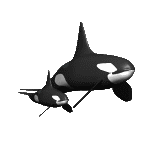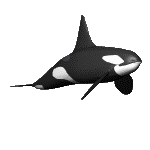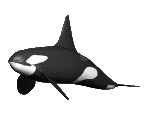The First Captive Killer Whale – A Changing Attitude
In recent decades, the world has come to be fascinated by Killer Whales. Prior to the mid-1960’s however, a Killer Whale was widely feared as dangerous, savage predator, a reputation based on rumor & speculation. In the waters of the Pacific Northwest along with many other regions worldwide, the shooting of Killer Whales was accepted and even encouraged by governments & the general public alike. The attitude towards Killer Whales finally began to change when  whales were first captured for oceaniums and we began to learn about Killer Whales as individuals. The first Killer Whale capture was in 1961 by Marineland of the Pacific in California. They captured a sick, disoriented mature female in Newport Harbor, CA. A couple of days after the introduction into her tank, she smashed her rostrum head-on into the tank’s wall and died.
whales were first captured for oceaniums and we began to learn about Killer Whales as individuals. The first Killer Whale capture was in 1961 by Marineland of the Pacific in California. They captured a sick, disoriented mature female in Newport Harbor, CA. A couple of days after the introduction into her tank, she smashed her rostrum head-on into the tank’s wall and died.
The next captive Killer Whale was in 1964. This did not start out as a live capture, but eventually ended up as the first to be kept in captivity for a lengthy period of time. A sculptor by the name of Samuel Burich was commissioned in 1964 by the Vancouver Aquarium to go out and kill a Killer Whale and fashion a life-sized model of it for the aquarium’s new British Columbia hall. Burich harpooned a 15-foot, 1-ton whale near East Point, Saturna Island in British Columbia. When the whale did not die immediately even after being shot, the aquarium’s director Dr. Murray Newman decided to keep the Killer Whale alive and tow the whale back to Vancouver, a 20-mile journey. He used the harpoon line attached to the base of the whales dorsal fin as the tow line. The harpooned whale that was towed to Vancouver was named “Moby Doll”, although later they found out he was male. People were surprised by “Moby Doll’s” docility. “Moby Doll” was kept in captivity for 87 days until he died from a skin disease caused by the harbor’s low salinity water.
For the first time, newspapers and magazines including Reader’s Digest, Life, The Times of London and the Victoria Times gave some positive press about Killer Whales. “Moby Doll’s” captivity started a new era for Killer Whales. Killer Whale captures for exhibition purposes began in the Northwest in 1965. The second capture in the Northwest was an accidental catch of a 24-foot, 5-ton male who got snared in a fishing net off Namu, British Columbia. The pair of fishermen who owned the net decided to sell him alive to the first person who gave them a bid. Ted Griffin owner of the Seattle Public Aquarium, had dreamed for many years of befriending a Killer Whale. Killer Whales are the largest of the dolphin family and he was convinced that such a relationship was possible. When Griffin heard of the captured Killer Whale, he jumped at the opportunity and bought the whale for $8,000, the cost of replacing the net. He named the whale “Namu” after the town (Namu, BC) where the whale was captured.
The main problem for Griffin however, was how to transport “Namu” 450 miles from Namu to Seattle. He solved this problem by building a 60′ by 40′ by 16′  deep floating pen that could be towed by boat to Seattle. The journey southward started in July 1965. When ”Namu” was being towed southward he emitted various scream-like sounds and on the 4th day of the trip, 30-40 Killer Whales overtook the floating pen and seemingly tried to help “Namu”. They repeatedly charged the cage, but they stopped just short of hitting it. After several hours, most of the Killer Whales disappeared, all except a female and two calves. These three whales were probably “Namu’s” mother and siblings and they stayed with “Namu” for 150 miles.
deep floating pen that could be towed by boat to Seattle. The journey southward started in July 1965. When ”Namu” was being towed southward he emitted various scream-like sounds and on the 4th day of the trip, 30-40 Killer Whales overtook the floating pen and seemingly tried to help “Namu”. They repeatedly charged the cage, but they stopped just short of hitting it. After several hours, most of the Killer Whales disappeared, all except a female and two calves. These three whales were probably “Namu’s” mother and siblings and they stayed with “Namu” for 150 miles.
“Namu” was an instant success when he arrived on July 28, 1965 in Rich Cove located 12 miles west of Seattle. “Namu’s” first Sunday at Rich Cove attracted 5,000 people and by September, the number of people who visited “Namu” exceeded 120,000. They all came to see the ‘killer turned tame’. Griffin wanted to dispel the notion that Killer Whales are blood thirsty predators whose only desire is to kill. Griffin knew that in order to prove this attitude wrong, he had to meet “Namu” on his own terms and in his own environment. Griffin decided that to demonstrate the friendliness of “Namu”, he had to swim with him. When people heard of Griffin’s plan to swim with “Namu”, they told him that ‘swimming with a Killer Whale is like risking death’. Before attempting the first swim ever with a wild Killer Whale, Griffin observed “Namu’s” every move, studied his behavior and noted his moods. Griffin reasoned that fear would not be a cause for aggression, since Killer Whales have no natural enemies in the wild. “Namu” should instead regard Griffin with curiosity.
Griffin first entered the water with “Namu” on August 27 1965, just one month after “Namu” arrived at Rich Cove. Griffin approached “Namu” with a short- handled brush. “Namu” did not move, so Griffin scrubbed “Namu’s” head and chin. Later in the day, Griffin slid onto “Namu’s” back and from that day on Griffin and “Namu” became inseparable. Griffin commented on his relationship with “Namu”, “It was as if my every conscious wish became the whale’s command”. “Namu” and Griffin performed together for 11 months until “Namu” contracted a bacterial infection which damaged his nervous system. A few days before his death he became unresponsive to people. “Namu” crashed head-on at full speed into the wire mesh of his pen, thrashed violently for a few minutes and then died. Griffin had become so enthralled by money and fame that despite his experience with “Namu’s” intelligent and friendly nature he still decided to capture more Killer Whales for oceaniums. In 1965, he began a partnership with Dan Goldsberry to capture even more Killer Whales from the Pacific Northwest.
Griffin, Goldsberry and others captured Killer Whales in the waters around Washington and British Columbia from November 1965 until August 1977. They seine netted the Killer Whales 19 different times and captured a total of around 262 whales. From those captured, they removed 50 juveniles. Weaned juveniles were targeted because they posed less risk during transportation and they still possessed the mental flexibility to adapt to a captive situation. Five other Killer Whales were removed from the population either because they were accidentally caught in nets or they had stranded. At least 11 Killer Whales died during the capture process, mostly by drowning in nets. The other Killer Whales were either released or they escaped. Sixteen of the whales in captivity died their first year.
The captors aimed for weaned juveniles because they posed less risk during transportation and they still possessed the mental flexibility to adapt to a captive situation. This has resulted in the absence of an entire generation of Killer Whales in the Pacific Northwest. Public and scientific concern arose because of the captures. People wanted restrictions to be introduced if Killer Whales were to be continually taken. It was unknown exactly how many whales were present in the population during the capture period. The assumption of the captors was that there were 100′s or perhaps 1,000′s of Killer Whales in these waters. This number was based on the assumption that Killer Whales were evenly distributed over the entire Pacific Ocean. Because of this concern, Canada’s Department of Fisheries and Oceans contracted an oceanic marine biologist Dr. Michael A. Bigg, to do a population census of Killer Whales in the waters around British Columbia. Some of the most fundamental questions that needed to be answered were:
perhaps 1,000′s of Killer Whales in these waters. This number was based on the assumption that Killer Whales were evenly distributed over the entire Pacific Ocean. Because of this concern, Canada’s Department of Fisheries and Oceans contracted an oceanic marine biologist Dr. Michael A. Bigg, to do a population census of Killer Whales in the waters around British Columbia. Some of the most fundamental questions that needed to be answered were:
What are the total number of Killer Whales inhabiting these waters?
Are these whales a discrete local population or are these Killer Whales just a few of the 1,000′s of Killer Whales inhabiting the entire Pacific Ocean that occasionally wander into these waters?
 whales were first captured for oceaniums and we began to learn about Killer Whales as individuals. The first Killer Whale capture was in 1961 by Marineland of the Pacific in California. They captured a sick, disoriented mature female in Newport Harbor, CA. A couple of days after the introduction into her tank, she smashed her rostrum head-on into the tank’s wall and died.
whales were first captured for oceaniums and we began to learn about Killer Whales as individuals. The first Killer Whale capture was in 1961 by Marineland of the Pacific in California. They captured a sick, disoriented mature female in Newport Harbor, CA. A couple of days after the introduction into her tank, she smashed her rostrum head-on into the tank’s wall and died. deep floating pen that could be towed by boat to Seattle. The journey southward started in July 1965. When ”Namu” was being towed southward he emitted various scream-like sounds and on the 4th day of the trip, 30-40 Killer Whales overtook the floating pen and seemingly tried to help “Namu”. They repeatedly charged the cage, but they stopped just short of hitting it. After several hours, most of the Killer Whales disappeared, all except a female and two calves. These three whales were probably “Namu’s” mother and siblings and they stayed with “Namu” for 150 miles.
deep floating pen that could be towed by boat to Seattle. The journey southward started in July 1965. When ”Namu” was being towed southward he emitted various scream-like sounds and on the 4th day of the trip, 30-40 Killer Whales overtook the floating pen and seemingly tried to help “Namu”. They repeatedly charged the cage, but they stopped just short of hitting it. After several hours, most of the Killer Whales disappeared, all except a female and two calves. These three whales were probably “Namu’s” mother and siblings and they stayed with “Namu” for 150 miles. perhaps 1,000′s of Killer Whales in these waters. This number was based on the assumption that Killer Whales were evenly distributed over the entire Pacific Ocean. Because of this concern, Canada’s Department of Fisheries and Oceans contracted an oceanic marine biologist Dr. Michael A. Bigg, to do a population census of Killer Whales in the waters around British Columbia. Some of the most fundamental questions that needed to be answered were:
perhaps 1,000′s of Killer Whales in these waters. This number was based on the assumption that Killer Whales were evenly distributed over the entire Pacific Ocean. Because of this concern, Canada’s Department of Fisheries and Oceans contracted an oceanic marine biologist Dr. Michael A. Bigg, to do a population census of Killer Whales in the waters around British Columbia. Some of the most fundamental questions that needed to be answered were: